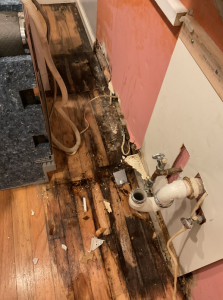Something people love about living in and visiting the Mid-Atlantic region is our diversity of seasons. We have mild springs, balmy summers, crisp autumns, and frigid winters (sometimes all in a single week!). However, one thing that tends to be hit-or-miss in the region are hurricanes. We avoided disaster after the terrible hurricane season of 2017, which brought four Category 4 or 5 storms to the United States. However, we haven’t been so lucky in past years (Superstorm Sandy anyone?).
Regardless of where you live, the impact of a hurricane causes financial hardship and crisis. On average, a major hurricane causes $28 million in damage to homes, business and infrastructure. During hurricanes and tropical storms, our properties become susceptible to damage in many different ways.

Water soaked ground and high storm winds can spell disaster for homes and businesses alike.
High winds that occur during storms can contribute to a myriad of damages. Debris caught in winds can be driven through windows, roofs, or even walls. Shingles and other roofing materials can become dislodged, causing roof damage and subsequent leaks. Tree limbs felled by wind damage can fall on buildings and utility lines. Another costly effect of storm damage is the unwelcome presence of indoor water. Water damage in hurricanes is often caused by storm surges in coastal areas, and flash floods. To add insult to injury, this water is often filthy and carries in debris and dangerous pathogens. Sometimes, rain water is driven indoors by those high winds through cracks in walls and roofs. During floods, overloaded storm sewers can backup into homes.
So what do you do? If you’re a concerned property owner, your storm planning gameplan is probably not “hope for the best.” While our odds of avoiding a hurricane are vastly better than Texas or Florida, we are still vulnerable to coastal storms. Luckily there are several great ways to help protect your property before a storm even hits.
Review your property insurance for storm coverage! You should periodically review your homeowner’s insurance policy to ensure you have sufficient coverage. You want to make sure that your property and valuables are covered in the event of a natural disaster or unexpected crisis. Things to look out for in your policy: roof damage, fallen trees, sewer backup, water damage, and loss due to extended power outages. Flood damage is typically EXCLUDED from most homeowners policies, so you may wish to contact your insurance agent to determine what kinds of water damage repair you are or are not covered for. You don’t want to wait until it’s too late to find out you don’t have coverage.

It’s not 100% possible to prevent all storm damage. However, there are many steps you can take to help.
Storm-proof your property!
- Keep area around your home free of debris, loose branches, and twigs– these can become projectiles in high winds. You should also trim back dead tree branches. These can fall from trees in storm events, causing property damage.
- Have a means to quickly secure any outdoor furnishings in case a storm arises. Trash cans, lawn chairs, umbrellas and planters can all blow free in a storm if not fastened down.
- Keep gutters clean. Heavy rains cause flood hazards in or around your home if water cannot run freely away from the property.
- Identify utility shutoff sources in your home, such as water mains and gas lines.
Build an emergency kit! This should include a three day supply of clean water for each member of your family (don’t forget pets!), a first aid kit, a battery-powered NOAA radio, a flashlight, and copies of important phone numbers and vital documents (such as your homeowners insurance information!). You may also wish to photograph your valuables (with serial number visible, when applicable) and keep these in a secure location. This information will assist in the event of an insurance claim.

If your property is affected by a severe summer storm, you’ll want to quickly begin the unenviable task of cleanup. You’ll want to begin repairing any hurricane damage quickly and safely. When dealing with a flood or water intrusion, the damage worsens the longer it sits. Be extra mindful of operating electrical appliances and lights in any standing water. You should strongly consider hiring a professional restoration firm to assist with any flood cleanup. Restoration companies (like Tri State Restorations) quickly turn a large problem into a manageable one by providing services such as:
- Immediate damage assessment.
- Water pumping and extraction.
- Removing damaged and unsalvageable building materials.
- Cleaning and restoration of damaged contents.
- Sanitation and disinfection of affected areas, to decontaminate mold and bacterial growth.
- Muck-out of mud or silt washed in from storm.
- Setting of specialized structural drying equipment.
- Temporary repairs such as roof tarping and door/window board-ups.
Don’t let storm damage go untreated! Contact Tri State Restorations within 24 hours to begin water mitigation and storm cleanup in Maryland, Washington, DC, or Virginia.
As always, Tri State Restorations has skilled storm damage experts on staff who are always available with advice. If you think you’re at risk of storm or water damage, we are standing by to schedule your priority inspection, consultation or an estimate. Call us today – 866-818-1949. We are proudly certified by the IICRC, the Indoor Air Quality Association, and the EPA.
#waterdamage #flooddamage #molddamage #stormcleanup #stormdamage #hurricanedamage #moldremoval #hurricaneflooding #hurricaneplanning
Sharing is caring!







